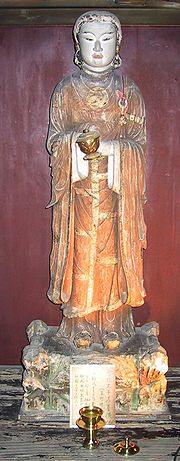Prince Shōtoku
| Prince Shōtoku | |
|---|---|
 |
|
| Prince Shotoku flanked by younger brother (left: Prince Eguri) and first son (right: Prince Yamashiro), woodblock painting | |
| Father | Emperor Yōmei |
| Mother | Princess Hashihoto no Anahobe |
| Born | 7 February 574 |
| Died | 8 April 622 (aged 48) |



Prince Shōtoku (聖徳太子 Shōtoku Taishi, 574–622), also known as Prince Umayado (厩戸皇子 Umayado no ōji), was a regent and a politician of the Asuka period in Japan. He was a member of the ruling Soga clan.[1]
Contents |
Cultural and political role
Shōtoku was appointed as regent (Sesshō) in 593 by Empress Suiko. Shōtoku, inspired by Buddha's teachings, and succeeded in establishing a centralized government during his reign. In 603, he established the 12 official ranks at court. He is credited with promulgating a Seventeen-article constitution, although contemporary scholars question the attribution based on its style.
The Prince was a supporter of Buddhism and composed commentaries on the Lotus Sutra, the Vimalakirti Sutra, and the Sutra of Queen Srimala. He commissioned the Shitennō-ji Temple in Settsu province (present-day Osaka). Shōtoku's name has been linked with Hōryū-ji, a temple in Yamato province. Documentation at Hōryū-ji claims that Suiko and Shōtoku founded the temple in the year 607. Archaeological excavations in 1939 have confirmed that Prince Shōtoku's palace, the Ikaruga-no-miya (斑鳩宮), stood in the eastern part of the current temple complex, where the Tō-in (東院) sits today.[2]
Although Shōtoku admired China from afar, China seems to have taken the initiative in opening relations with Japan. Sui Emperor, Yangdi (kensui taishi), dispatched a message in 605 that said:
- "The sovereign of Sui respectfully inquires about the sovereign of Wa."[3]
Shōtoku responded by sponsoring a mission led by Ono no Imoko in 607. The Prince's own message contains the earliest written instance in which the Japanese archipelago is named "Nihon", literally, sun-origin. The salutation said:
- "From the sovereign of the land of the rising sun (nihon/hi izuru) to the sovereign of the land of the setting sun."[4]
He is said to be buried at Shinaga, in the former Kawachi province (today Osaka prefecture)[5].
Titles and name
Shōtoku is known by several titles, although his real name is Prince Umayado (厩戸皇子 Umayado no ōji, literally the prince of the stable door) since he was born in front of a stable.[6] He is also known as Toyotomimi (豊聡耳) or Kamitsumiyaō (上宮王). In the Kojiki, his name appears as Kamitsumiya no Umayado no Toyotomimi no Mikoto (上宮之厩戸豊聡耳命). In the Nihon Shoki, in addition to Umayado no ōji, he is referred to as 豊耳聡聖徳, 豊聡耳法大王, and 法主王.
The name by which he is best known today, Prince Shōtoku, first appeared in Kaifūsō, written more than 100 years after his death in 751.
Controversy
In the Tokyo Shimbun, February 10, 2008, Chubu University professor Ōyama Seiichi argued Prince Shōtoku was not a historical person at all.[7] Other historians dispute this claim.[8][9][10][11]
See also
- Asuka-dera
- Kokki
- Tennōki
- Sangyō Gisho
- Jōgū Shōtoku Hōō Teisetsu, biography of Shōtoku Taishi
References
- ↑ http://www.khyentsefoundation.org/patronkingsVIII.html
- ↑ John Whitney Hall (1988). The Cambridge history of Japan, "The Asuka Enlightenment," p. 175. Cambridge University. http://books.google.com/books?vid=ISBN0521223520&id=x5mwgfPXK1kC&pg=PA175&lpg=PA175&dq=horyu+ji&sig=By1En3KeXjbvBKO1vuggU7mU0Lo. Retrieved 2007-04-03.
- ↑ Varley, Paul. (1980). Jinnō Shōtōki, p. 128.
- ↑ Varley, Paul. (1973). Japanese Culture: A Short History. p. 15
- ↑ Guth, Christine. "The Divine Boy in Japanese Art." Monumenta Nipponica 42:1 (1987). p12.
- ↑ http://www.answers.com/topic/shotoku-taishi
- ↑ Prince Shōtoku, Tokyo Shimbun 2008-02-10 誇張や粉飾があったにしても、実在と非実在では話の次元が全く違ってしまいます。ところが、積み重ねられた近代の実証的歴史学の結論は「聖徳太子はいなかった」で、どうやら決定的らしいのです。(Modern historians conclude that Prince Shōtoku was a fictional character) 太子像が創作(fabricated)・捏造(later created)となると...(Japanese)
- ↑ (Japanese) "Shoutoku Taishi wa Jitsuzai Shita no ka [Did Prince Shotoku exist?]"]. Teikoku Shoin. http://www.teikokushoin.co.jp/teacher/junior/bookmarker/pdf/200509h/bookmarker2005.09-14.pdf/%E4%B8%AD%E6%AD%B42005.09-14%E3%80%8C%E8%81%96%E5%BE%B3%E5%A4%AA%E5%AD%90%E3%81%AF%EF%BD%9E%E3%80%8D%E4%BB%81%E8%97%A4%E6%95%A6%E5%8F%B2.pdf. Retrieved 2008-09-25.
- ↑ (Japanese) "Shoutoku Taishi wa Jitsuzai Suru ka [Does Prince Shotoku exist?]". 青山学院校友会千葉県東葛支部. http://www.aoyama-matsudo.com/shohtoku-taishi-ishda.htm. Retrieved 2008-09-25.
- ↑ (Japanese) "Shoutoku Taishi Kyokou-setsu wo haisu [Ruling out the theory that Prince Shotoku did not exist]". http://www.amazon.co.jp/%E8%81%96%E5%BE%B3%E5%A4%AA%E5%AD%90%E8%99%9A%E6%A7%8B%E8%AA%AC%E3%82%92%E6%8E%92%E3%81%99-%E7%94%B0%E4%B8%AD-%E8%8B%B1%E9%81%93/dp/4569638279. Retrieved 2008-09-25.
- ↑ (Japanese) "Shoutoku Taishi wa jitsuzai shita [Prince Shotoku did exist]". Yamataikoku no kai. http://yamatai.cside.com/katudou/kiroku249.htm. Retrieved 2008-09-25.
Literature
- Varley, H. Paul. (1973). Japanese Culture: A Short History. New York: Praeger Publishers.
- Varley, H. Paul , ed. (1980). [ Kitabatake Chikafusa (1359)], Jinnō Shōtōki ("A Chronicle of Gods and Sovereigns: Jinnō Shōtōki of Kitabatake Chikafusa" translated by H. Paul Varley). New York: Columbia University Press. ISBN 0-231-04940-4
- Como, Michael A. Shotoku: Ethnicity, Ritual and Violence in the Japanese Buddhist Tradition. New York: Oxford University Press, 2008. ISBN 978-0-19-518861-5
External links
 Media related to Prince Shōtoku at Wikimedia Commons
Media related to Prince Shōtoku at Wikimedia Commons